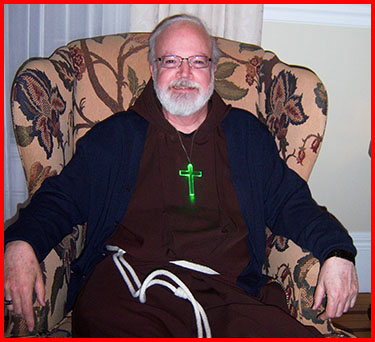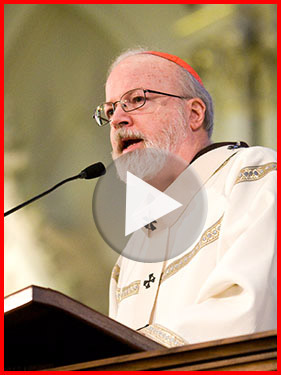Welcome and a blessed Holy Week to you all!
I begin my post this week remembering two notable individuals who recently passed to the Lord.
Chiara Lubich, who founded the Focolare Movement in Italy in 1943, expired at 88 years of age last week. She was an extraordinary figure in our contemporary Church. Thousands gathered for her funeral at the Basilica of St. Paul Outside the Walls in Rome. You can watch a news video of the ceremony available through our archdiocesan newspaper’s web site, TheBostonPilot.com here.
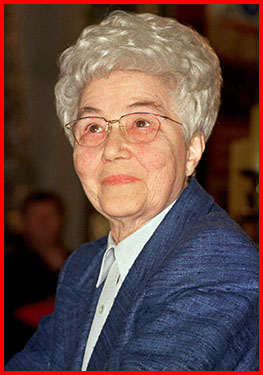
As a young woman in Trent, she was a teacher and a parishioner at one of the Capuchin parishes there. She became a member of the Third Order of St. Francis, taking the name of Chiara, which is Italian for Claire.
During World War II, she used to gather in the bomb shelters with some of her friends and there would read from the scriptures, taking one phrase which they called “La Parola di Vita,” which means “The Word of Life.” Then, they would try to live that word intensely for a month. At the end, they would come together and reflect on how they had lived that word. The first word they chose was from the Gospel of John: “that all might be one.”
The great theme of Chiara’s spirituality, like St. Francis’ desire to be a universal brother, was to restore that unity that Christ longs for. Her movement, which she considered a Marian movement and called “La Opera di Maria,” has attracted many thousands of people who live this spirituality throughout the world.
As a young priest I was exposed to this wonderful movement through Adalberto Martinez, one of my parishioners who came from Paraguay. He later became one of my priests in the Virgin Islands and is now the bishop of San Pedro. I was privileged to attend a couple of the meetings that they have for bishops who are friends of the movement at Castel Gandolfo. Pope John Paul II gave them part of the pope’s summer residence as a conference center for the Focolare movement.
Pope John Paul II saw in these new ecclesial realities a very special movement of grace in the life of the Church, which gives people a deep sense of community, a wonderful formation in the faith, a personal spirituality and motivation to evangelize.
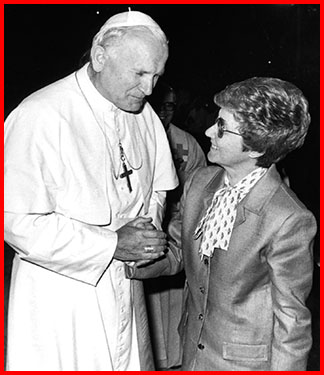
With the death of Chiara Lubich, we mourn her loss, but we know that her legacy lives on in the thousands of people — consecrated religious, priests and laity — who live her spirituality.
– – –
Last week we were all saddened by the news of the death of Iraqi Archbishop Paulos Faraj Rahho.
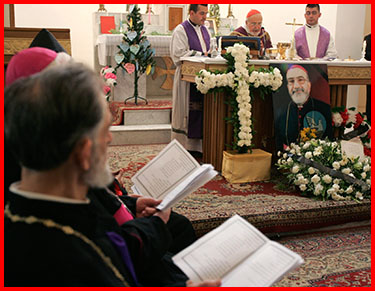
I did see photographs of his funeral. It was very moving to see that thousands of people came, Catholics as well as Muslims, to bury this brave archbishop. We pray for peace in that country and for his people, the Chaldean Catholics who are being driven out of Iraq.
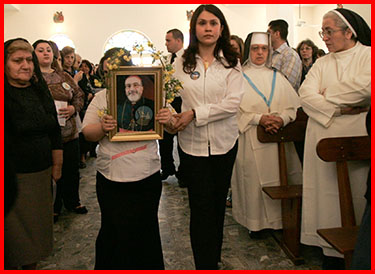
– – –
A few days ago I was interviewed by Father Vincent Cabanac, an Assumptionist priest who writes for the French Catholic weekly Pélerin, which is the largest French religious magazine. He was interested in our bicentennial, the archdiocesan plans in the near future and our reactions to the Holy Father’s visit to the United States. Father Cabanac also interviewed Cardinal Egan of New York and Archbishop Migliore, the Vatican’s nuncio to the United Nations.
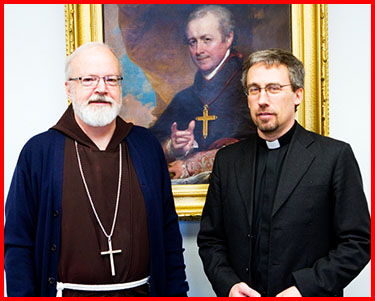
On Oct. 10 last year, I was visited by Bishop Michel Dubost of the French Diocese of Evry-Corbeil-Essonnes, accompanied a large group of journalists from the Bayard group. Bayard is a very large French publishing group that was founded by the Assumptionists in the 19th century and that includes Father Cabanac’s publication as well as Catholic Digest here in the United States.
– – –
On March 8 we had the pleasure to baptize Patrice Therese Fox, the child of Charles and Michelle Fox in the Cathedral chapel.
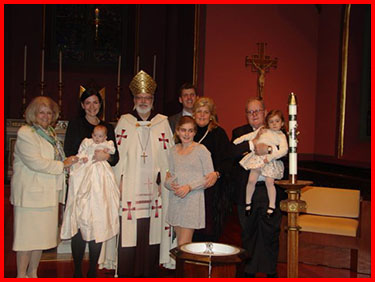
Little Patrice is the grandchild of Charles and Janice Fox who have been very involved with the Order of Malta and many other Catholic organizations. Janice is also a very active supporter of Laboure College.
– – –
On Saturday, St. Joseph’s Day, I visited the Jeanne Jugan Residence in Somerville, run by the Little Sisters of the Poor. The sisters have great devotion to St. Joseph, so I try to go there on his feast day whenever I can.
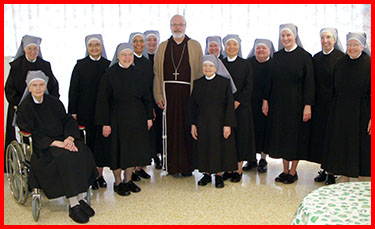
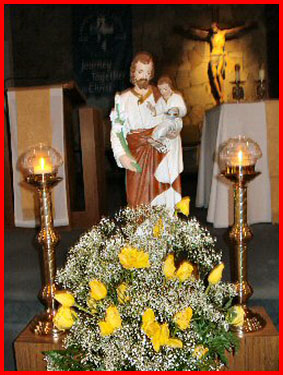
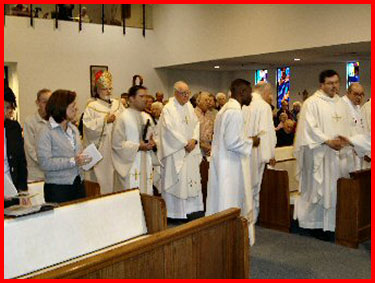
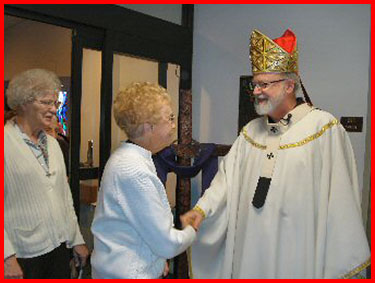
While I was there, I helped distribute gifts to all the residents and the staff. Everyone there really creates a very homelike atmosphere, and there is a great sense of joy. Mother Celine is the superior and has done an outstanding job there.
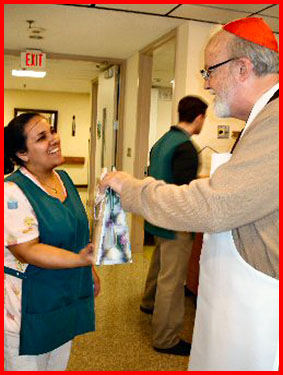
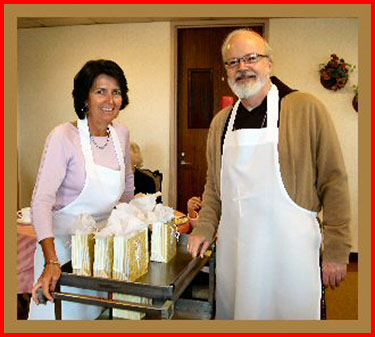
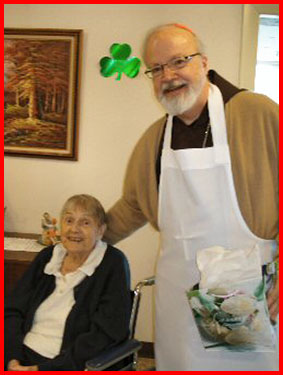
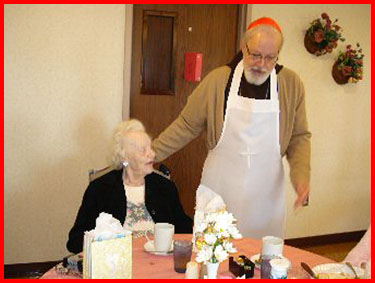
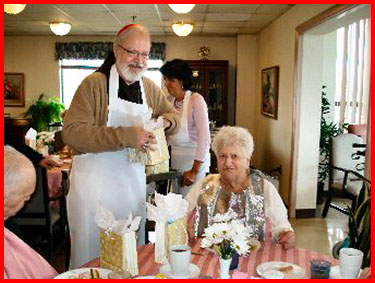
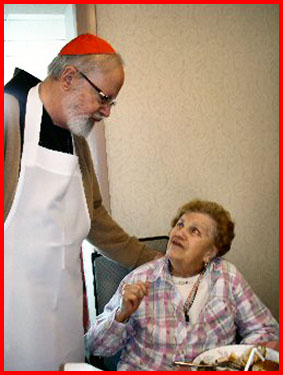
The chaplain there, Jesuit Father William Raftery, has done a wonderful job. He has a sister in the community who is currently working in Malaysia.
– – –
On Palm Sunday, I went to St. Mary Parish in Franklin, which is one of the largest parish in the archdiocese.
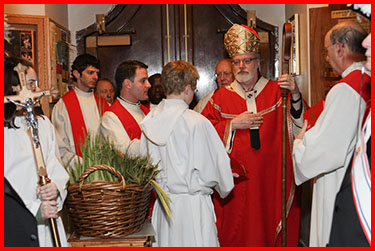
Blessing the palms
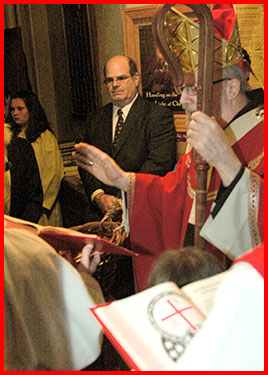
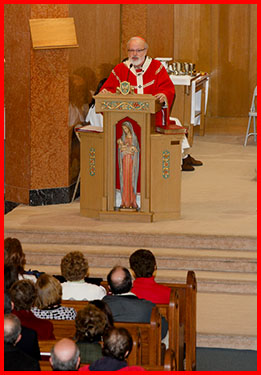
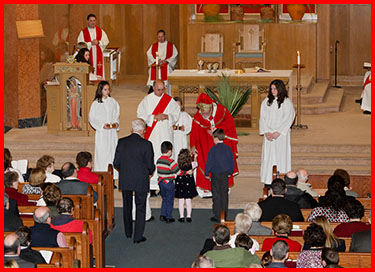

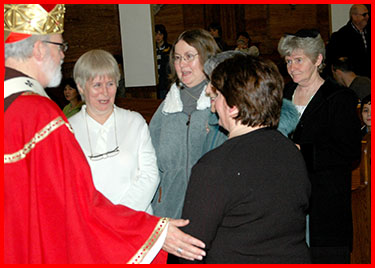
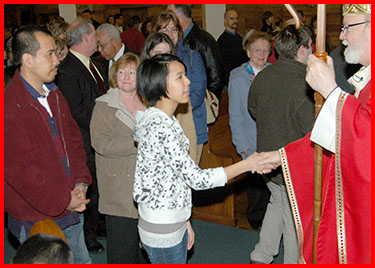
– – –
On March 17, we celebrated the Monday of Holy Week and honored St. Patrick at the Cathedral of the Holy Cross. In Boston, where it is a civil holiday, we opted to keep the commemoration of St. Patrick’s Day on March 17. The liturgical celebration was that of Holy Monday with that very beautiful Gospel reading from St. John about Mary, sister of Lazarus, anointing Jesus’ feet and preparing him for burial.
The Mass had an Irish atmosphere with readings in Gaelic and Irish hymns. One hymn, “Our Lady of Knock,” was sung during communion. It is a beautiful meditation and one of my favorite hymns.

I also blessed the shamrocks, which were distributed to the people.
For St. Patrick, the shamrocks symbolized both the cross and the blessed Trinity.

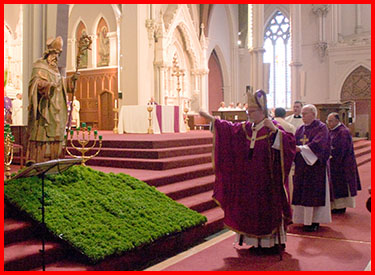
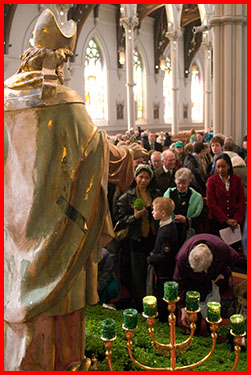
In my homily, I reflected on St. Patrick as a great missionary, a man who courageously shared his faith with the Irish. He inspired many Irish people to become evangelizers, which led to one of the greatest efforts of evangelization in the history of the Church. Many, many Irish monks left Ireland and carried the Gospel all over Europe.
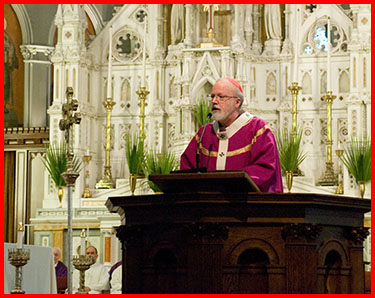
There were many officials who attended the Mass — both from Ireland and the United States. Here is the list:
Commissioner Roderick Fraser, Boston Fire Department
From Ireland:
The Honorable David Barry, Consul General of Ireland
Ms. Marianne Bolger, Vice Consul, Boston
The Honorable Brian Linehan, Minister Justice of Ireland, Equality and Law Reform – visiting from Ireland
Mrs. Ann Linehan, mother of Minister Linehan
Secretary General Sean Alyward – Department of Justice, Equality and Law Reform and Mrs. Agnes Alyward
Garda Commissioner Fachtna Murphy, and Mrs. Anne Murphy
Chief Inspector of the Garda, Kathleen O’Toole, and Mr. Dan O’Toole
Ms. Catherine Byrne, Embassy of Ireland, Washington, D.C.
Ms. Sinead McGuinness, Private Secretary to the Minister
Mr. Dale Sunderland, Press Advisor to the Minister
From Great Britain:
The Honorable Phil Budden, Consul General of Great Britain
The Honorable Joseph Pickerill, Consul General for Present Public Affairs
The Honorable Paul Goggins, Minister for Northern Ireland.
– – –
Msgr. Charles Anadore died at Regina Cleri, the archdiocesan residence for senior priests in Boston, on March 12. He was 94 years old and he was very much loved and respected by both the people he served and his fellow priests.
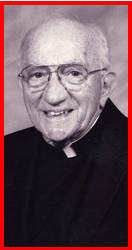
The funeral Mass took place on Monday, coinciding with the Mass at the Cathedral, so I could not attend. Bishop Hennessey was the principal celebrant at the funeral and Father Peter Casey, Pastor of St. Agatha in Milton, was the homilist and I want to share with you a small excerpt of his homily that someone has forwarded to me:
“In the midst of the sadness that Msgr. Anadore’s death brings, we rejoice because our faith tells us that it is in dying that we are born to eternal life. Gentle, loyal, humorous, attentive, compassionate, understanding, present, gift, supportive, poet, artist; these are but a few of the words I have heard describing this most beloved priest. With each descriptive word there was a story and each story, in some way, spoke of how this man, this priest, was the presence of the Lord’s love and compassion.”
– – –
Holy Thursday has two liturgies — one is the Mass of Chrism and the other is the Mass of the Lord’s Supper. The Church allows us to anticipate the Chrism Mass so as to allow greater participation. In Boston, we traditionally celebrate it on Tuesday of Holy Week and hundreds of priests come to participate as well as many faithful.
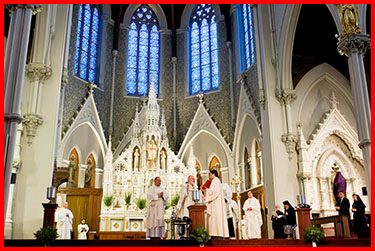
It is one of the most significant and moving celebrations of the year. At the Mass, we bless the oils that will be used in all of the baptisms, anointing of the sick, ordinations and confirmations in the coming year. It is a sign of our unity as a presbyterate that these oils that we are blessing in this Mass will be used in the administration of the sacraments all over the archdiocese. The Chrism Mass is also where we as priests renew our priestly commitment to Christ and to serve the Church.
This year, we had a full cathedral for the Chrism Mass with 400 priests. We also had a beautiful sunny day, and the music was outstanding.
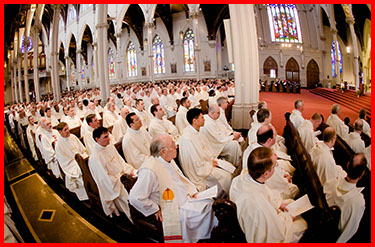
The theme of my homily was the priest as a man of communion. I’d like to share the text with you here.
You can also click on the image below to view a multimedia presentation of the homily recorded at the cathedral.
A husband was in big trouble when he forgot his wedding anniversary. His wife told him, “Tomorrow there better be something in the driveway for me that goes from 0 to 200 in 10 seconds flat.” The next morning the wife found a small package in the driveway. She was momentarily confused but thought perhaps she might find the keys to a new sports car in the package. Unfortunately, when she opened it, she found a brand new bathroom scale!
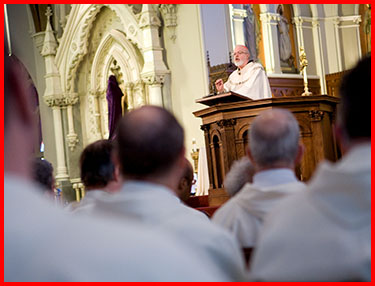
Unrealistic expectations and assumptions that are not shared are hard on marriages and are our greatest enemy in renewing our presbyterate. But our Chrism Mass with the renewal of our priestly commitment is a wonderful place to start. Our commitment to celibacy, to obedience, to prayer and to teach the Catholic faith, and pastoral service to God’s people help define us as priests, but also what defines us is our connectedness to each other in this presbyterate. We are cultic priests celebrating the sacraments and we are servant leaders. It is not an either/or proposition, and we are priests together.

Recently I heard a comment about a brother priest, “That man marches to his own tune.” The music is the William Tell Overture and the lyrics end with “Hi ho, Silver.” Unfortunately, we all know the profile. What is our identity? How do we see ourselves? How do people see us? Visiting a nursing home, I heard one of the residents say when she saw me, “I have a statue of him in my patio.” I thought to myself, I hope it’s not a birdbath.
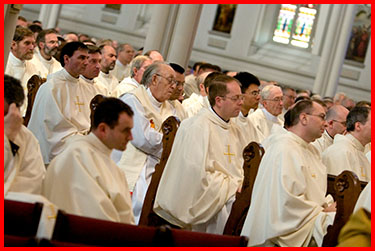
Once after Mass, I was greeting the parishioners as they left the Church. One father carrying a small child asked the little boy as he pointed to me. Do you know who that is? Sometimes children say: God, the Pope, Santa Klaus, but without missing a beat, the kid says, “He’s the communion guy.” I like that. Ex ore infantium. A priest is the communion guy.
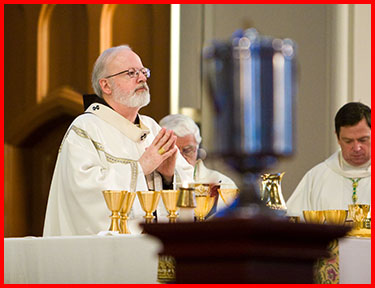
Today as we come together to reflect on our identity as priests and our mission in the world, I would like to focus on a phrase used by John Paul II in Pastores Dabo Vobis. He speaks of the priest as a “man of communion”, “the communion guy.” It is a marvelous insight into the identity of the priest and perhaps the best antonym for the phrase, the “lone ranger.” Our ideal is to become “men of communion” to borrow the Pope’s phrase.
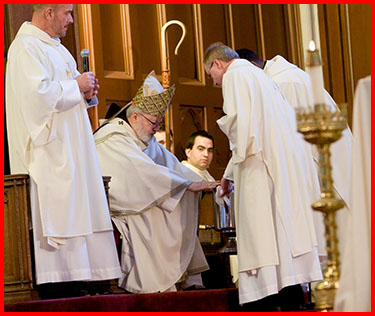
The word koinonia (communion) occurs 20 times in the New Testament. The primary meaning is fellowship, sharing in common, communion.” The first occurrence of koinonia is in Acts 2:42, “They devoted themselves to the Apostles’ teaching and to fellowship, the breaking of the bread and to prayer.”
William Barklay’s New Testament Words has a section on the word koinonia. He says koinonia means sharing a friendship that is based on common Christian knowledge. Only those who are friends with Christ can really be friends with each other in John’s Epistles. In Paul, koinonia means sharing with the less fortunate. Paul uses the expression three times in connection with the collection he took up for the poor saints in Jerusalem. Paul also uses communion to mean partnership in the work of Christ.
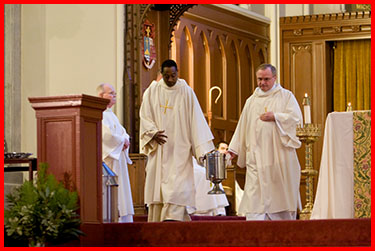
We are called to koinonia with Christ and that koinonia is found especially through the Eucharist. The cup and the bread are supremely the koinonia of the body and blood of Christ. In the sacrament above all we find Christ and find communion with each other. Further, that fellowship with Christ is fellowship with His suffering.
But as John reminds us, our communion with God, is ethically conditioned, for it is not for those who have chosen to walk in darkness. The Christian koinonia binds us to each other, to Christ to our Heavenly Father.
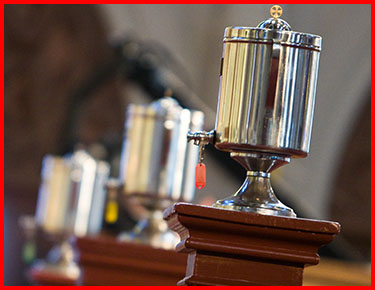
The oils blessed at the Chrism Mass are the oil of the sick, the oil of catechumens and the chrism
The often-used phrase “one another” in the English version of the New Testament helps us to capture the deep meaning of the koinonia. In the New Testament, we read phrases like: devoted to one another (Rom 12:10), honor one another (12:10) live in harmony with one another (Rom 12:16, 1 Peter 3:8), accept one another (Rom 15:7), serve one another in love (Galatians) be compassionate and kind to one another (Eph 4:32) admonish one another (Col 3:16), encourage one another (1 Thes 5:11, Hebrews 3:13), spur one another on toward love and good deeds (Hebrews 10:24), offer hospitality to one another (1 Peter 4:9) and of course in the Holy Thursday Gospel of John Jesus washes the feet of His Apostles to give us an example of koinonia and the New Commandment —to love one another. This is what koinonia looks like in the Scriptures.
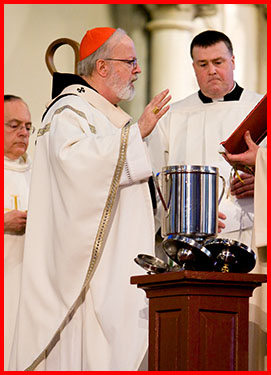
Blessing the Oil of Catechumens
A priest is a man of koinonia, a man of communion. Being men of communion begins with our attachment to Christ, the High Priest, the Good Shepherd, the Bridegroom. The Spirit that anointed Him and that descended on the Apostles at Pentecost has anointed us in our ordination to be priests. We must know that the Spirit is guiding the Church and is acting in our ministry.
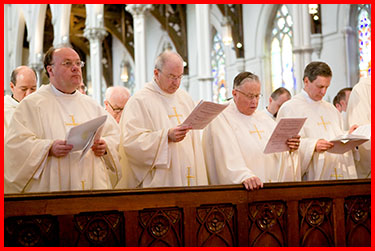
During the Chrism Mass, we renew our priestly vows
The more we love the same things the more we can grow into a united presbyterate. The pastoral theology of the Second Vatican Council should be our agenda, but not an overly personalized interpretation of the council that leads to deep divisions among priests. Our ongoing formation should help us in developing a common vision that can inspire and inform our pastoral approach and allow us to grow closer to another. Ongoing formation is key in building a united presbyterate, I am convinced.
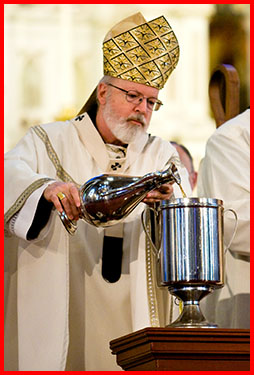
Adding balsam to the Chrism oil
In Pastores Dabo Vobis, Pope John Paul II had this to say: “The ordained ministry has a radical ‘communitarian’ form and can only be carried out as a ‘collective work.’ The Vatican Council dealt extensively with this communal nature of the priesthood, examining the relationship of the priest with his own bishop, with other priests and with the lay faithful.” (# 17)
When I say that as priests we are called to koinonia, to be “men of communion,” I am referring to the radical communitarian form of our ministry. Father Ronald Knott who has written quite convincingly on intentional presbyterates says that sadly enough: “Parrochialism and the priesthood go together almost by definition.” By contrast, the theology of the priesthood presented by the Council and Pope John Paul II is one of “an intimate sacramental brotherhood.”
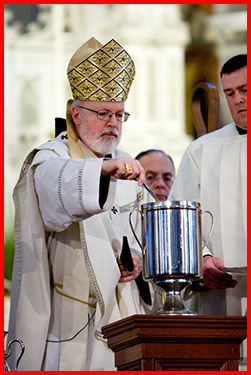
Then the balsam is mixed in
This theology of priesthood was very apparent in the early Church in the New Testament and the writings of the Fathers. They did not think so much in terms of solitary priests but of a college or presbyterium that surrounded the Bishop and collaborated with him.
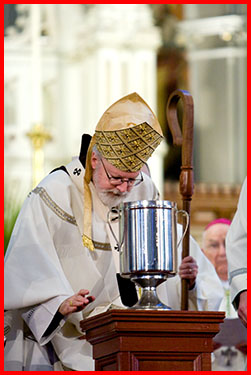
After mixing in the balsam the bishop breathes on the chrism as a sign of the Holy Spirit coming down
Over the years with the adoption of the benefice system, the growth of local Churches and other historical factors have all contributed to the collapse of a strong notion of collegial ministry. However, there is a growing awareness of the need to restore the emphasis on the communitarian form of the priesthood by working for stronger unity in our presbyterates. In the Basic Plan for the Ongoing Formation of Priests, the American Bishops write: “Priests are not priests simply one by one, but they are priests and serve the mission of the Church in a presbyterate in union with the Bishop. The corporate sense of priestly identity and mission, although not fully developed even in official documents, is clearing emerging as an important direction for the future.”
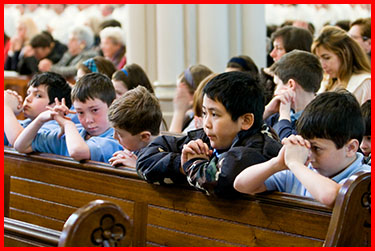
As Father Knott observed many priests have gone into “private practice.” These private practitioners often form tribes within the presbyterate which are destructive of unity and priestly fraternity. Without a shared vision, small groups of like-minded priests are left to battle over who has the right vision.
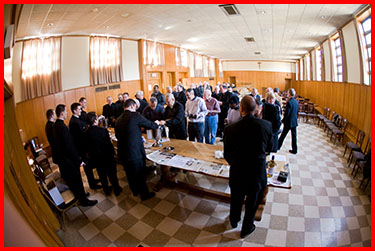
Back at St. John’s Seminary, the oils are distributed for use in the parishes
A unified intentional presbyterate requires that we all desire to achieve it by working together to direct our individual accomplishments toward a common goal. “We must accurately identify and confront the personal attitudes which impede and imperil presbyteral unity: competition, clashing ecclesiologies, clerical envy, lack of regard for various backgrounds, languages, cultures and ethnicities that exist in the presbyterate.
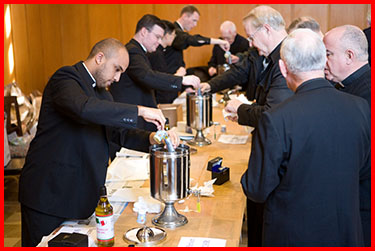
One way to build presbyteral unity is by being a prophet of hope rather than a prophet of doom. We must learn to encourage one another, to celebrate each others’ successes and to recognize the gifts that each has received so that together we can build up the body of Christ.
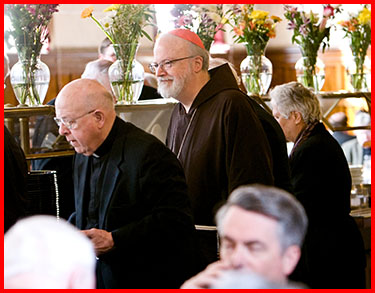
The day of fraternity continues with the Chrism Mass Luncheon at the seminary
Only after having asked Peter, “Do you love me?” does the Lord say: “Feed my sheep.” Having been assured of Peter’s love, then Jesus entrusted to him the task of ministry.
Our service of God’s people must flow out of our friendship with Christ. But when Jesus speaks about shepherding, He is not talking about a brave, lonely shepherd who takes care of a large flock of obedient sheep. In many ways, He makes it clear that ministry is a communal and mutual experience.
In the New Testament the Apostles are called “the twelve,” and the deacons “the seven,” showing them as a team, a college. And when Jesus sends the disciples out to evangelize, He sends them two by two. Jesus is teaching us that we cannot proclaim the Good News on our own. We are called to proclaim the Gospel together, Jesus says, “If two of you on earth agree to ask anything at all, it will be granted to you by my Father in heaven. For where two or three gather in my name, I am in your midst.”
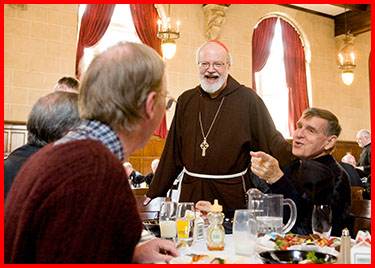
In one of Nouwen’s writings on ministry, he says that his movement from Harvard University to L’Arche made him aware of how much his thinking about Christian leadership had been affected by the desire to be relevant, the desire for popularity, and the desire for power, He goes on to discover that Jesus has sent us out to be shepherds and Jesus promises a life in which we increasingly have to stretch out our hands and be led to places we would rather not go. He asks us to move from concern for relevance to a life of prayer, from worries about popularity to communal and mutual ministry and from leadership built on power to a leadership in which we critically discern where God is leading us and our people. Unfortunately, the tools to build communion are too often left unused.
Once many years ago in a land far away, I was in the box hearing confessions. A priest came and very piously made his confession. Trying to demonstrate a modicum of creativity, I said: “Father, for your penance pray the Te Deum. He said, “Where can I find it?” I said, “Three Our Fathers and three Hail Marys.” So much for creativity. I did not have the heart to tell him that the prayer is in his breviary — obviously a terra incognita to this priest.
All of you have heard of the breviary adjustment service. For a very reasonable fee of $25.00, the service provides that within hours after your death someone will go to your rectory and place the ribbons in your breviary in the proper corresponding places.
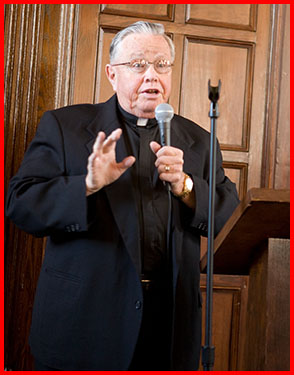
Each year the priests of the diocese nominate two of their peers for special recognition. Of course, then we make them say a few words! This year we honor Father James Lyons…
There is a special supplementary service offered for Bishops. If the Bishop expires while reading the minutes of the presbyteral council they will come and put the Imitation of Christ in his hands. It is what the Irish call cleaning up the obituary.
In this prayer of communion, the Liturgy of the Hours, we are praying the Scriptures, the word of God, that later we are called upon to preach to God’s people. We pray it in union with countless brothers and sisters throughout the world. We pray it with Christ our Head. This is why I like praying the office with others. It is a prayer of koinonia and helps us be men of communion.How many times each week people ask for our prayers. The people of God expect us, need us to be men of prayer. The great prayer of communion is the Divine Office, the Liturgy of the Hours. It is a prayer that pulls us out of isolation and puts us in contact with priests, religious and faithful who are joined to others throughout the world who praise and intercede — along with and in the name of Christ, our High Priest.
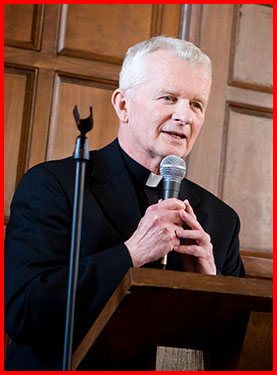
… and Father Paul Keyes
Like Moses beseeching God for mercy after the sin of the golden calf, the priests, the men of communion, beg God to pardon His peoples’ forgetfulness, failures and weakness and to help them in their deepest needs. This is easier to do when we are aware of those sick in the hospital, of couples desperately trying to save their marriage, of young people who struggle with drugs and gangs, of a family who has lost a son or a daughter in Iraq, of a brother priest whose life and purpose is becoming unraveled. The Liturgy of the Hours helps us to be men of communion.
The Chrism Mass is full of signs of the call to be men of communion as Christ’s priests. It is typically the largest concelebrated Mass in our liturgical year. It is the Mass where we bless the oils to be used in the administration of the Sacraments by all our priests and deacons and bishops. The baby being baptized in Plymouth, the dying patient being anointed in Brockton, the young girl confirmed in Lowell, the deacons being ordained to the priesthood in June will all be touched by this oil we bless here today. The oils become the toils of our common ministry as members of this presbyterate.
The other sign of our communion is the fact that we renew our priestly promises together during the Chrism Mass. I am always impressed by the courage and integrity of Bishop Cheverus who refused to take the oath of the “Civil Constitution of the Clergy.” Rather than betray his ordination promises, Cheverus endured imprisonment and exile. Others sought accommodation with the Revolution and the Anti-Catholicism of the times.
As we renew these promises, let us ask for the grace to forge a united, an intentional presbyterate with a deep sense of our connectedness to Christ and to one another, to be shepherds who are men of communion, part of a sacramental brotherhood.
Mr. Dan Kennedy in the moving eulogy he gave at Father Dan’s funeral a few weeks ago shared with us that before his ordination, Father Dan Kennedy said to Dad in a very personal conversation about his vocation, “I am going to be a priest, and I am going to do it well.”
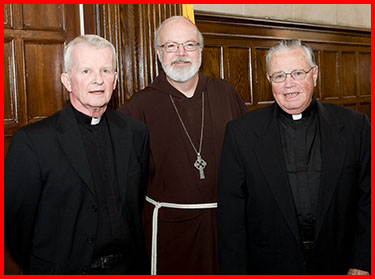
In this Chrism Mass, in our renewal of our priestly commitment, we are saying the same thing to God, to our people, to each other. We are Christ’s priests, we are going to do this well, and we are going to do it together — thank you for being communion guys.
– – –
Wednesday evening we had the Tenebrae service at the cathedral, which is marked by the extinguishing of candles until the congregation is surrounded by darkness. Tenebrae is the old form of celebrating the Liturgy of the Hours for Holy Week. When I was a priest in Washington D.C., it was always part of the cathedral services there. So later when I became a bishop in the Virgin Islands, Fall River and Palm Beach, I incorporated the Tenebrae service, as I have also done here in Boston.
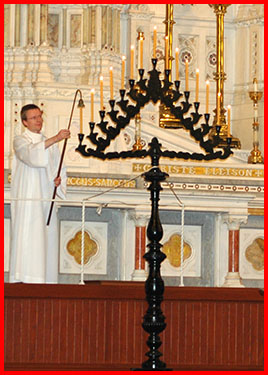
The liturgical books call for some of the Divine Office to be prayed publicly in the cathedral during Holy Week, and I believe Tenebrae is a very beautiful way to do this. It is a little bit more of a dramatic way, with the candles, and a lot of the musical arrangements are so beautiful, particularly the Latin motets that our choir sings so well. They do that “In Monte Oliveti” and the “O vos omnes” by Casals. It is always a very beautiful way to begin the Triduum. It is held on Wednesday night, but the offices that we say are taken from the Holy Thursday matins and lauds.
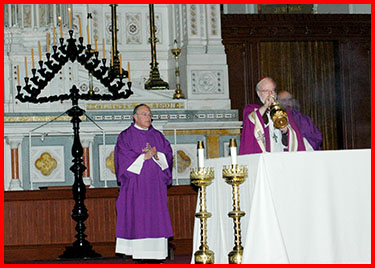
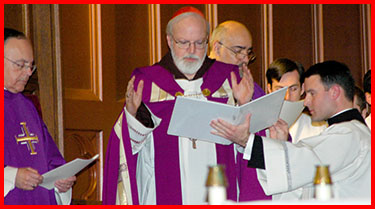
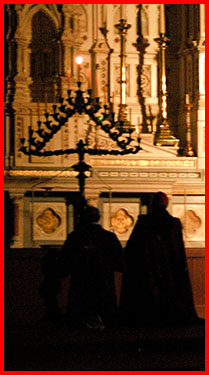
– – –
Last Sunday I had dinner one night with Father Simeon Gallagher, who is a classmate of mine. He is a very fine preacher who has given missions in many of our parishes here in the archdiocese.
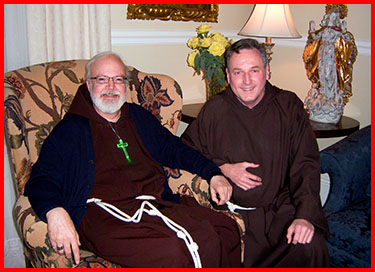
For the photo of the week I have chosen this picture, in which you will see that I am wearing a luminous green cross that the youth gave me when I was on the March for Life back in January. It looks like it is crystal, but it flashes green on and off. I wore that in honor of St. Patrick’s Day.
